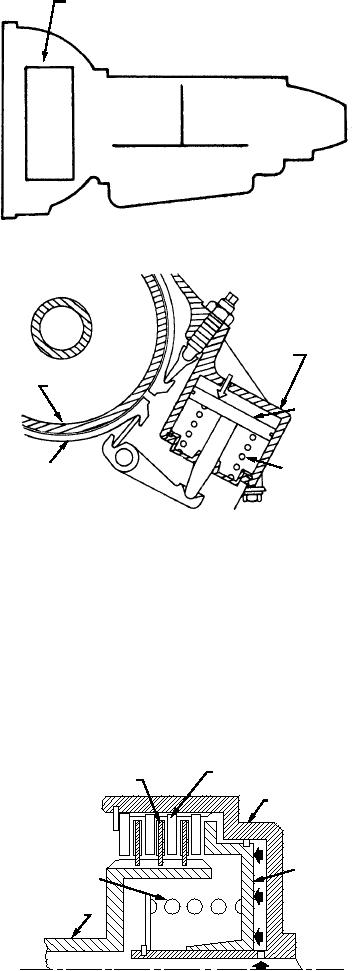
Complex Planetary Gear System
TORQUE CONVERTER
As in the case of simple machines, complex
planetary systems are merely combinations of two or
more of the simple planetary units. Planetary units can
be arranged to provide several different conditions or
HYDRAULIC
RANGE
gear ratios. However, only two of these conditions can
OPERATING
SECTION
be used for each unit--either direct drive and a gear
UNITS
reduction, or reverse and direct drive. This shows that a
HYDRAULIC
single planetary unit is actually a two-speed
CONTROL UNIT
transmission. All that is needed to operate the unit is a
ASf02062
way to hold any one member to provide a reduction in
speed (torque increase), and a way to lock any two
members together for direct drive. Of course, the single
Figure 2-62.--Representative transmission groups.
unit would not provide the tractive torque and variable
speeds necessary on some types of support equipment.
For this reason most automatic transmissions contain
two or more planetary units (complex planetary
system) arranged to provide the required tractive
CYLINDER
torque for starting and moving heavy loads, and also
(SERVO
providing variable forward speeds as well as a reverse
BODY)
DRUM OR
gear.
RETAINER
PISTON
There are inherent advantages to the planetary gear
system. For example, since each gear of the planetary
FRICTION
BAND
unit is in contact with at least two other gears of the
SPRING
unit, there is a lot of gear tooth contact to carry the load.
Another advantage is that the gears are always in mesh,
ASf02063
and there is no tooth damage due to tooth clash or
Figure 2-63.--Servo unit.
partial engagement. However, the big advantage, and
pressure applied to the piston into mechanical force,
the one that makes it so popular, is the ease of shifting
thus controlling the application of the brake (friction)
gears, which can be done automatically.
band. When the brake band is applied, a member of a
planetary gear unit is held stationary, providing a
CONSTRUCTION OF AN AUTOMATIC
specific gear ratio.
TRANSMISSION
The clutches, like the servo units, normally use
The components of an automatic transmission can
hydraulic pressure for their actuation and a return
be divided into four groups--the torque converter, the
spring for release. Clutches can be of various designs,
range or gearing section, the operating units, and the
but most are the multiple friction disc type (fig. 2-64).
hydraulic control units. These four groups are shown in
The clutch discs can be wet or dry--the major
figure 2-62. The torque converter and range or gear
CLUTCH PLATE
section incorporating the use of a planetary gear train
CLUTCH DISC
(two or more planetary units) were discussed earlier.
CLUTCH
Therefore, only the operating units and hydraulic
RETAINER
control units are discussed in depth in this section.
Operating Units
PISTON
RELEASE SPRING
SHAFT
The operating units of the transmission are the
AND DISC HUB
servos and clutches. The servo unit (fig. 2-63) consists
of the servo body (containing the cylinder, piston, and
return spring) and the friction band (attached to the
APPLY PRESSURE
body), which is used to stop or hold a rotating drum or
ASf02064
Figure 2-64.--Multiple disc clutch unit.
retainer. The servo simply converts the hydraulic
2-49

